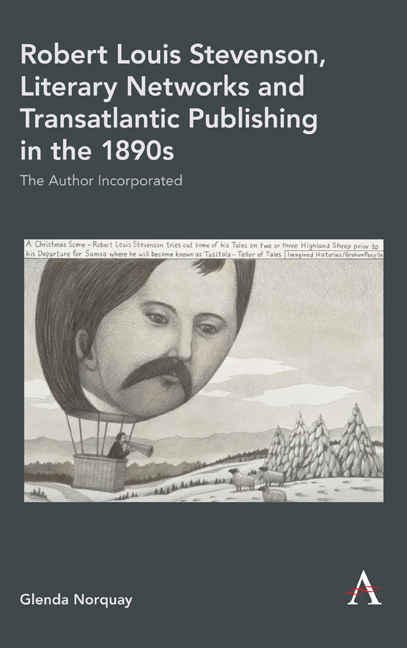 Robert Louis Stevenson, Literary Networks and Transatlantic Publishing in the 1890s
Robert Louis Stevenson, Literary Networks and Transatlantic Publishing in the 1890s Book contents
- Frontmatter
- Contents
- Acknowledgements
- Abbreviations
- Introduction
- 1 Lemuel Bangs: ‘The Senator’
- 2 A Tale of Two Texts
- 3 ‘A Gentleman Called Charles Baxter’
- 4 Sidney Colvin: Custodian and Monument
- 5 Family, Friends and Collaborators
- 6 Arthur Quiller-Couch: The Quivering Needle
- 7 Richard Le Gallienne: ‘Not While a Boy Still Whistles’
- Conclusion: Robert Louis Stevenson Incorporated
- References
- Index
- Frontmatter
- Contents
- Acknowledgements
- Abbreviations
- Introduction
- 1 Lemuel Bangs: ‘The Senator’
- 2 A Tale of Two Texts
- 3 ‘A Gentleman Called Charles Baxter’
- 4 Sidney Colvin: Custodian and Monument
- 5 Family, Friends and Collaborators
- 6 Arthur Quiller-Couch: The Quivering Needle
- 7 Richard Le Gallienne: ‘Not While a Boy Still Whistles’
- Conclusion: Robert Louis Stevenson Incorporated
- References
- Index
Summary
Robert Louis Stevenson produced powerful personal, literary and professional attachments among those who knew him. ‘Stevenson’, wrote American publisher, Samuel S. McClure, ‘was the sort of man who commanded every kind of affection; admiration for his gifts, delight in his personal charm, and respect for his uncompromising principles’. His stepdaughter, Isobel Field, recalled in later life, ‘A stranger had only to associate with Louis for a few weeks and ever after he would unconsciously imitate his odd twists of the English language and many of his mannerisms.’ Andrew Lang famously noted that Stevenson ‘possessed, more than any man I ever met, the power of making other men fall in love with him’. This meant, Lang continued, that people ‘warmed their hands at that centre of light and heat’. Stevenson was desired, imitated and adopted on more than a personal level. His style inspired other writers; he was imagined as the desired reader by aspiring novelists; and, although challenging conventional constructions of creativity in his writing habits, he epitomized the romantic author in the public imagination. In his career, the work, person and idea of ‘RLS’ were subject to complicated transatlantic transactions as business representatives, mentors, publishers, imitators and admirers all took on parts of that frail yet international Stevensonian body. After his early death, these networks reshaped themselves in response to economic exigencies, shifting reading publics and challenges to authorial reputation. The afterlife of Stevenson's writing and literary identity was again shaped by geographical, technological and aesthetic contexts in transition.
The unusual degree to which Stevenson was ‘incorporated’ – taken on as a business by those around him, situated within national cultures and literary genres, represented by competing interests in different parts of his authorial identity, and invested with personal emotion – makes him a particularly illuminating instance of the volatile literary field of the 1890s. Publishers were seeking new markets across the Atlantic, facing the challenges of copyright legislation and learning to work with authorial representatives or agents. The complexities of Robert Louis Stevenson's geographical, financial and literary situation demonstrate, in sharp detail, the ways in which the permeable bodies of ‘author’, ‘critic’, ‘editor’, ‘publisher’, ‘agent’, ‘reader’ and ‘celebrity’ were being fixed and re-fixed. The lens of literary modernism has focused on these increasingly complex bifurcations of cultural commodities.
- Type
- Chapter
- Information
- Robert Louis Stevenson, Literary Networks and Transatlantic Publishing in the 1890sThe Author Incorporated, pp. 1 - 28Publisher: Anthem PressPrint publication year: 2020


